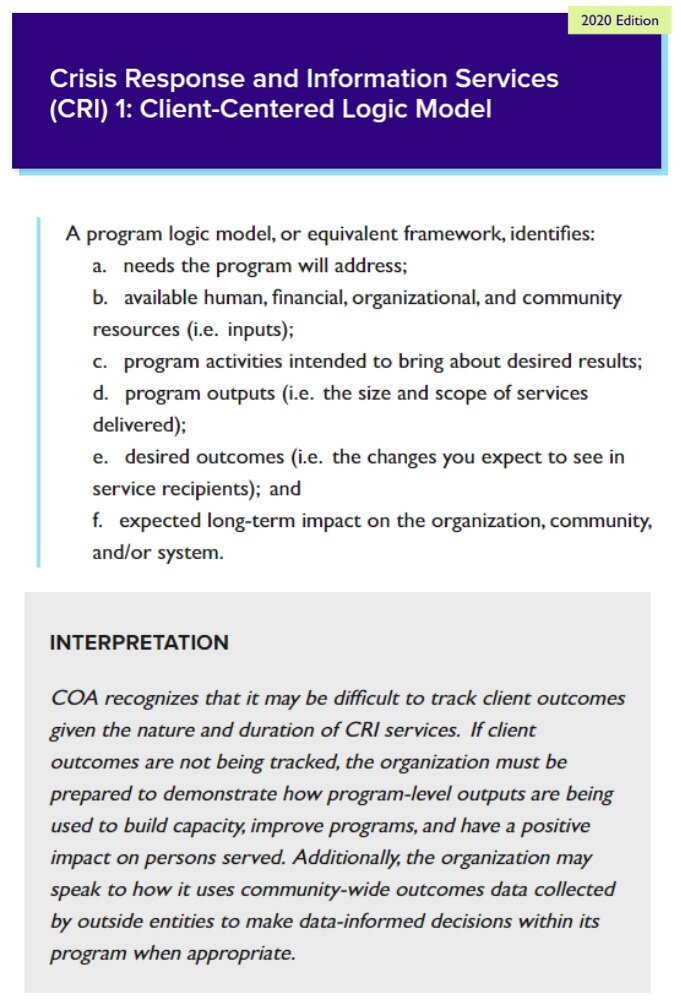COA 2020 Edition | FAQs About the Logic Model Standards
This is Part II of a series on the thinking behind the Council on Accreditation (COA)’s 2020 Edition updates. Visit Part I here.
As we mentioned in Part I of this series, the goal of the COA 2020 Edition Standards is to promote the development of effective, mission-driven organizations that are equipped to meet the needs of their clients. Strategic planning is the vehicle by which an organization can move towards closing the gap between where they want to be (their mission) and where they are today.
That is why we have introduced a new Core Concept standard on Logic Models into every service section of the 2020 Standards. These will guide organizations to think systematically about the client outcomes they hope to achieve, the ultimate impact each of their programs is intended to have, and how the program will utilize its assets and resources to achieve its goals.
Below are answers to some commonly asked questions about the new Client-Centered Logic Model Core Concept.
Q: Why did COA strengthen our standards for program logic models?
A: In order to achieve something, you first need to define what you are trying to achieve! Funders are already asking organizations to demonstrate how they are achieving their mission, as well as what impact their programs have on the people they serve. Completing a program logic model is a proven method for identifying how a program will use its assets, resources, and program activities to promote desired outcomes and have its intended effect.
Quality improvement is one of the aspects of COA accreditation that presents a challenge for organizations. It is also one of those that has the biggest impact. A logic model, or an equivalent framework, concisely demonstrates an organization’s quality improvement efforts at the program level.
Q: Why is COA creating a greater focus on outcomes?
A: Once you know what you want to achieve and how you will do it, you then need to measure your success. It is essential for organizations to demonstrate their program’s effectiveness through the use of data. Measuring outcomes is one mechanism to do this, as it helps determine the level of performance or achievement that occurred over time because of the services provided (i.e. how services are changing the lives of their service recipients).
This is why it’s important to define and measure outcomes. Without knowing the intended result, it becomes difficult to demonstrate the true impact of the services provided.
In many ways, outcomes represent the hallmark of service provision; they help an organization articulate why someone should come to this organization for services. Outcomes data can also help organizations make informed decisions about their resource needs and how those resources should be allocated in order to sustain positive change.
Q: Is COA rating organizations on whether or not they achieve the intended outcomes?
A: No, we are not rating an organization on the success of their outcomes. Instead, we look at: 1) an organization’s implementation of a framework for defining their success, 2) how they measure that achievement, and 3) what changes they make based on that data. The logic model is intended to support programs–and ultimately the organization–by providing organizations with a tool to demonstrate to themselves, their communities, and their funders that their programs are producing the desired impact.
Q: What is the difference between an outcome and output?
A: Outcomes indicate a change over time as a result of an active intervention. Within the context of programs, outcomes represent what the program expects services recipients to leave with (e.g. improved quality of life; decreased depressive symptoms, etc.). Outcomes answer questions such as: has the service recipient’s behavior improved? Have parenting skills improved? Has knowledge been gained in a particular subject?
Outputs state what was produced or activities conducted. Outputs quantify the activities and should always be connected to a numerical value. Examples of outputs include: number of visits made, number of people served, number of counseling sessions.
Note: Due to the nature of some services it is difficult to measure outcomes over time, so the standards are slightly different. For example, Crisis Response and Information Services (CRI) only includes one standard regarding the logic model as well as an interpretation.

Here at COA, we are optimistic about how the implementation of logic models can help organizations blaze new paths toward improved service delivery and outcomes. By starting with the end in mind, we in the human and social services field can focus on what matters most and has the greatest impact.
Have an unanswered logic model question? Send us an email!
For more information on the changes in the 2020 Edition and who they affect, download our overview here. Accredited and in-process organizations can also access two recorded webinars with in-depth information in their MyCOA portal (under the tools tab). If you are new to COA and have questions about the standards or process changes, feel free to contact us!


